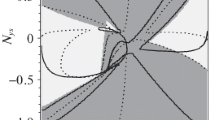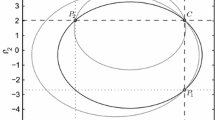Abstract
The discovery of the asteroid Ceres by Piazzi in 1801 motivated the development of a mathematical technique proposed by Gauss, (Theory of the Motion of the Heavenly Bodies Moving about the Sun in Conic Sections, 1963) which allows to recover the orbit of a celestial body starting from a minimum of three observations. Here we compare the method proposed by Gauss (Theory of the Motion of the Heavenly Bodies Moving about the Sun in Conic Sections, New York, 1963) with the techniques (based on three observations) developed by Laplace (Collected Works 10, 93–146, 1780) and by Mossotti (Memoria Postuma, 1866). We also consider another method developed by Mossotti (Nuova analisi del problema di determinare le orbite dei corpi celesti, 1816–1818), based on four observations. We provide a theoretical and numerical comparison among the different procedures. As an application, we consider the computation of the orbit of the asteroid Juno.
Similar content being viewed by others
References
Gallavotti, G.: 1980, In: P. Boringhieri (ed), Meccanica Elementare,Torino, seconda edizione (1986), pp. 498–516.
Gauss, C.F.: 1809, Theory of the Motion of the Heavenly Bodies Moving about the Sun in Conic Sections, English Translation, New York, Dover Publ., New York 1963.
Gauss C.F.: 1817, in Gotting. Gelehrte Anzeigen 144, 1433–1438.
P.S. Laplace (1780) ArticleTitle‘Memoires de l’Académie Royale des Sciences de Paris’ Collected Works. 10 93–146
T. Levi–Civita (1904) ArticleTitle‘Sopra la equazione di Kepler’ Rendiconti Acc. Nazionale Lincei. 13 260–268
F.R. Moulton (1914) An Introduction to Celestial Mechanics The Macmillan Company New York
Mossotti O.F.: 1942a, Sopra la Determinazione delle Orbite dei Corpi Celesti per Mezzo di Tre Osservazioni, Scritti’, Pisa, Domus Galileana, original version: “Memoria Postuma”, 1866
Mossotti O.F.: 1942b, ‘Nuova analisi del problema di determinare le orbite dei corpi celesti [1816–1818], Scritti’, Pisa, Domus Galileana.
von Zach F.X.: 1801, ‘Fortgesetzte Nachrichten über den längst vermutheten neuen Haupt–Planeten unseres Sonnen–Systems’, Monatliche Correspondenz, pp. 279–283.
Author information
Authors and Affiliations
Corresponding author
Rights and permissions
About this article
Cite this article
Celletti, A., Pinzari, G. Four Classical Methods for Determining Planetary Elliptic Elements: A Comparison. Celestial Mech Dyn Astr 93, 1–52 (2005). https://doi.org/10.1007/s10569-005-8663-8
Received:
Revised:
Accepted:
Issue Date:
DOI: https://doi.org/10.1007/s10569-005-8663-8




